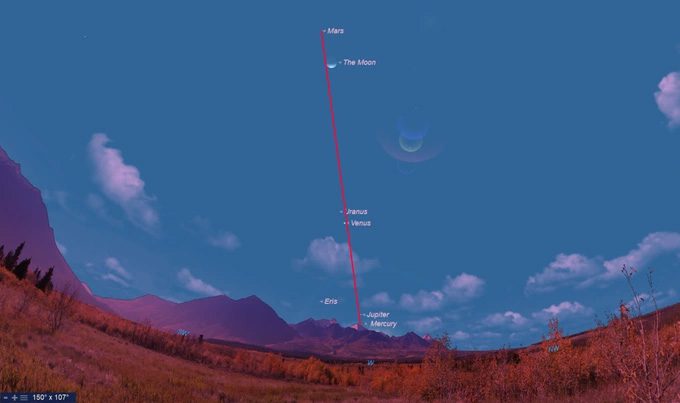A “planetary parade” is set to take place, and it is considered one of the most notable astronomical phenomena of 2023.
Jupiter, Mercury, Venus, Uranus, Mars, along with Earth’s Moon, are preparing to align when observed in the sky on the nights from March 25 to March 30.
According to Space, Mercury and Jupiter will be the first two planets to appear in a straight line. However, observing them will be quite challenging, as both will remain hidden below the horizon for 25-30 minutes after sunset.

5 planets will appear aligned in the night sky on March 27. (Photo: Space).
In contrast to the previous two, Venus—also known as the Morning Star—will be very easy to observe in the sky due to its brilliant luminosity.
Next is Mars, which, despite appearing only 1/13 as bright as it did in early December 2022, is still ranked among the 21 brightest stars in the sky. As of March 27, Mars will be 211.4 million kilometers away from Earth, more than 2.5 times its distance prior to winter.
The fifth celestial body is Uranus, which presents a bit of a challenge, as it is nearly impossible to see with the naked eye, even on clear nights.
Interestingly, Earth’s Moon, as well as M35, a star cluster in the Gemini constellation, will also participate in this “parade.” These are two significant objects, as they are often used to help locate the remaining planets in the night sky.
It is known that these planets orbit the Sun at different speeds and trajectories. Therefore, the alignment of the five planets is a fascinating event that rarely occurs.
According to Business Insiders, observers will likely need to use telescopes to fully appreciate this intriguing “lineup.”
In June 2022, five planets, including Mercury, Venus, Mars, Jupiter, and Saturn, also formed a straight line above the horizon. All five planets were visible early in the morning in the Northern Hemisphere and were relatively easy to observe.


















































